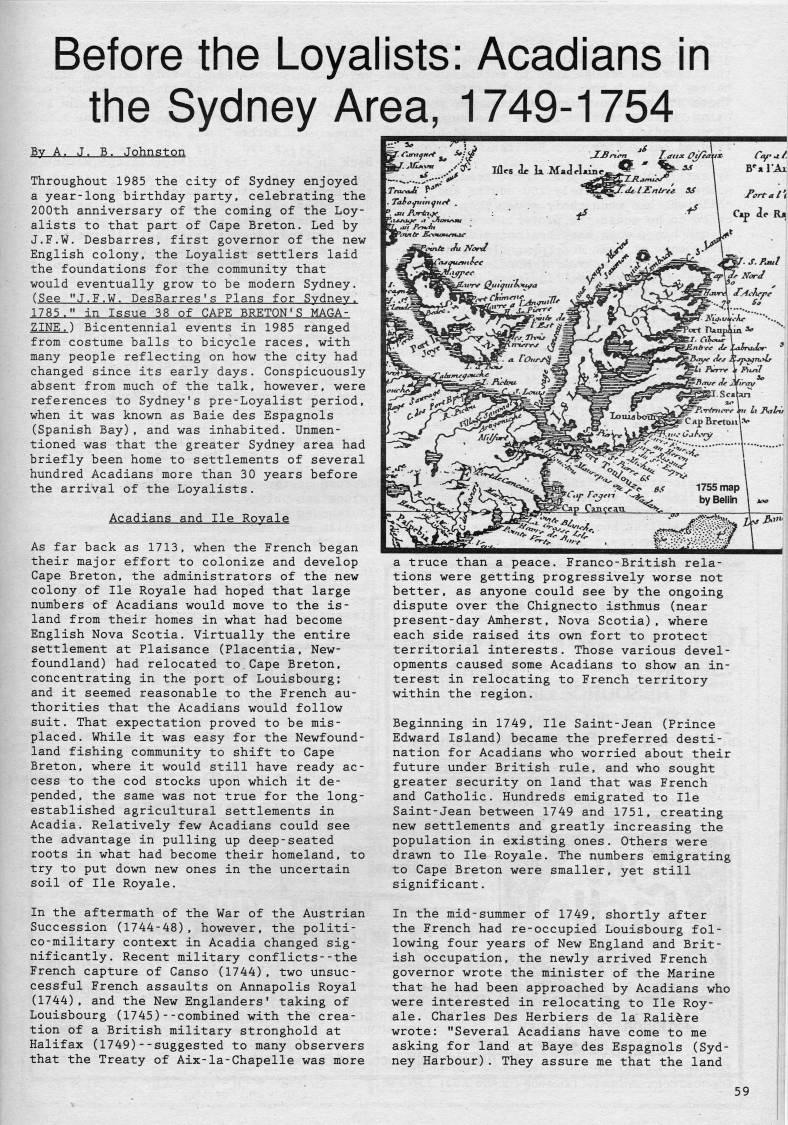Page 59 - Before the Loyalists: Acadians in the Sydney Area, 1749-1754
Published by Ronald Caplan on 1988/6/1 (902 reads)
 Page 58 - Aunt Annie MacLeod, Wreck Cove
Page 58 - Aunt Annie MacLeod, Wreck Cove
Page 60 - Before the Loyalists: Acadians in the Sydney Area, 1749-1754

Before the Loyalists: Acadians in the Sydney Area, 1749-1754 Bv A. J. B. Johnston Throughout 1985 the city of Sydney enjoyed a year-long birthday party, celebrating the 200th anniversary of the coming of the Loy? alists to that part of Cape Breton. Led by J.F.W. Desbarres, first governor of the new English colony, the Loyalist settlers laid the foundations for the community that would eventually grow to be modern Sydney. (See "J.F.W. DesBarres's Plans for Sydney. 1785." in Issue 38 of CAPE BRETON'S MAGA? ZINE. ) Bicentennial events in 1985 ranged from costume balls to bicycle races, with many people reflecting on how the city had changed since its early days. Conspicuously absent from much of the talk, however, were references to Sydney's pre-Loyalist period, when it was known as Bale des Espagnols (Spanish Bay), and was inhabited. Unmen- tioned was that the greater Sydney area had briefly been home to settlements of several hundred Acadians more than 30 years before the arrival of the Loyalists. Acadians and lie Royale As far back as 1713, when the French began their major effort to colonize and develop Cape Breton, the administrators of the new colony of lie Royale had hoped that large numbers of Acadians would move to the is? land from their homes in what had become English Nova Scotia. Virtually the entire settlement at Plaisance (Placentia, New? foundland) had relocated to,Cape Breton, concentrating in the port of Louisbourg; and it seemed reasonable to the French au? thorities that the Acadians would follow suit. That expectation proved to be mis? placed. While it was easy for the Newfound? land fishing community to shift to Cape Breton, where it would still have ready ac? cess to the cod stocks upon which it de? pended, the same was not true for the long- established agricultural settlements in Acadia. Relatively few Acadians could see the advantage in pulling up deep-seated roots in what had become their homeland, to try to put down new ones in the uncertain soil of lie Royale. In the aftermath of the War of the Austrian Succession (1744-48), however, the politi? co-military context in Acadia changed sig? nificantly. Recent military conflicts--the French capture of Canso (1744), two unsuc? cessful French assaults on Annapolis Royal (1744), and the New Englanders' taking of Louisbourg (1745)--combined with the crea? tion of a British military stronghold at Halifax (1749)--suggested to many observers that the Treaty of Aix-la-Chapelle was more a truce than a peace. Franco-British rela? tions were getting progressively worse not better, as anyone could see by the ongoing dispute over the Chignecto isthmus (near present-day Amherst, Nova Scotia), where each side raised its own fort to protect territorial interests. Those various devel? opments caused some Acadians to show an in? terest in relocating to French territory within the region. Beginning in 1749, lie Saint-Jean (Prince Edward Island) became the preferred desti? nation for Acadians who worried about their future under British rule, and who sought greater security on land that was French and Catholic. Hundreds emigrated to lie Saint-Jean between 1749 and 1751, creating new settlements and greatly increasing the population in existing ones. Others were drawn to lie Royale. The numbers emigrating to Cape Breton were smaller, yet still significant. In the mid-summer of 1749, shortly after the French had re-occupied Louisbourg fol? lowing four years of New England and Brit? ish occupation, the newly arrived French governor wrote the minister of the Marine that he had been approached by Acadians who were interested in relocating to lie Roy? ale. Charles Des Herbiers de la Rali're wrote: "Several Acadians have come to me asking for land at Baye des Espagnols (Syd? ney Harbour). They assure me that the land 59
 Page 58 - Aunt Annie MacLeod, Wreck Cove
Page 58 - Aunt Annie MacLeod, Wreck Cove
Page 60 - Before the Loyalists: Acadians in the Sydney Area, 1749-1754

Adobe Acrobat Reader is required to the PDF version of this content. Click here to download and install the Acrobat plugin



